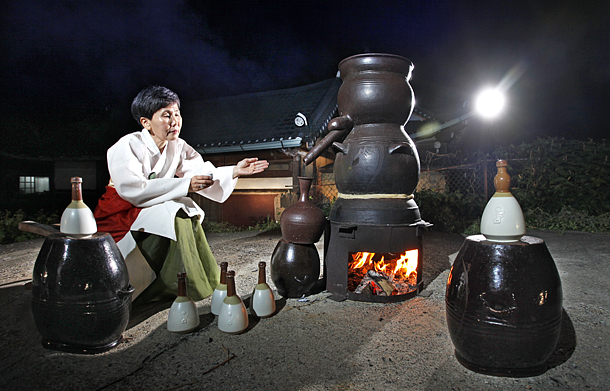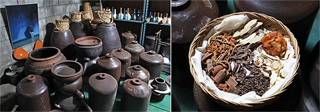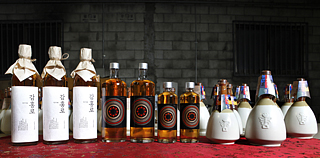Keeping a rare brewing legacy alive

Lee Ki-sook shows how soju is distilled in the traditional way as part of the process of making the herbal spirit gamhongro. [PARK SANG-MOON]
Traces of alcohol have been found in jars in China’s Henan province dated back to around 7,000 B.C., while evidence of wine cultivation in the Caucasus region has been traced back to 6,000 B.C.
Koreans were drinking rice wine well before the Three Kingdoms Period (57 B.C. to A.D. 668). They brewed rice and served it to their ancestors to pray for good fortune. After such rituals, they drank the alcohol and celebrated with song and dance.

Left: Old equipment used to make soju. Right: Seven kinds of natural herbs are added to make gamhongro, one of the top three traditional liquors of the Joseon Dynasty. The drink is known to have a reddish color with a slight sweetness that warms the body. [PARK SANG-MOON]
There is, for instance, gamhongro, literally “sweet red dew,” which was considered one of the three best liquors of the Joseon Dynasty (1392-1910). This drink has been passed down by Lee Ki-sook, the 60-year-old daughter of Lee Kyung-chan (1915-1993), who was known for his ability to brew moonbaeju, a drink made from wheat and millet that has been placed on the National Intangible Cultural Heritage list. In modern times, gamhongro has only ever been produced within Lee’s family.
In former times, Koreans enjoyed gamhongro so much that it even appears in a traditional folk tale, titled “Byeoljubu-jeon,” which is about a turtle luring a rabbit into the sea to use its liver in order to cure its ailing king. The rabbit takes the bait when the turtle tells it that there is a plentiful supply of gamhongro lying in wait beneath the sea.
Before passing away, Kyung-chan taught the art of brewing to his two sons. Ki-choon, the elder son, learned the recipe for moonbaeju while Ki-yang, the younger son, was taught how to make gamhongro.
When Ki-yang died in 2000, gamhongro almost disappeared from the world forever, but feeling the dire need to pass on her father’s legacy, Ki-sook started making gamhongro based on what she had seen her father do.

Different types of gamhongro products now available, all of which are produced by Lee Ki-sook. [PARK SANG-MOON]
Her husband, Lee Min-hyung, also helped out in the process. In 2005, the couple succeeded in establishing an agricultural corporation for gamhongro, with Min-hyung standing as its representative to this day. In 2012, Ki-sook was designated an expert on traditional food by the Ministry of Agriculture, Food and Rural Affairs.
In order to make gamhongro, the brewing process essentially comprises two steps. First, Ki-sook acquires soju by ripening nonglutinous rice and millet in water for around two weeks, and then she distills the result. After letting it sit for about two months, she distills the soju once more, then puts it aside for two to three more months before adding seven kinds of natural herbs, including dried orange peels, ginger, cinnamon and licorice, to name a few.
After another two months, she removes the herbs and rests the liquor for a year. The whole process takes eighteen months and leaves Ki-sook with a clear, precious new bottle of gamhongro.
“I want to continue to make and enjoy gamhongro and treat the recipe like it’s a part of the family,” said Ki-sook. “I would like to give this legacy to my children, as well.”
BY PARK SANG-MOON [moonpark@joongang.co.kr]










with the Korea JoongAng Daily
To write comments, please log in to one of the accounts.
Standards Board Policy (0/250자)